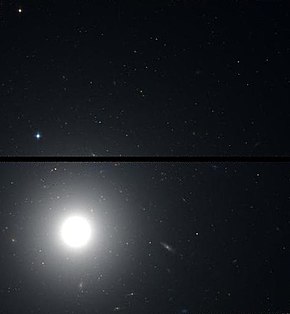NGC 1407
| NGC 1407 | |
|---|---|
 NGC 1407 by Hubble Space Telescope | |
| Observation data (J2000 epoch) | |
| Constellation | Eridanus |
| Right ascension | 03h 40m 11.9s[1] |
| Declination | −18° 34′ 48″[1] |
| Redshift | 1,779 ± 9 km/s[1] |
| Distance | 76 Mly (23.3 Mpc)[1] |
| Apparent magnitude (V) | 9.7 |
| Characteristics | |
| Type | E0[1] |
| Apparent size (V) | 4′.6 × 4′.3[1] |
| Other designations | |
| ESO 548- G 067, PGC 13505[1] | |
NGC 1407 is an elliptical galaxy in Eridanus. It is at a distance of 76 million light-years from Earth. It is the brightest galaxy in the NGC 1407 Group, part of the Eridanus Group, with NGC 1407 being its brightest member.[2] NGC 1400, the second-brightest of the group lies 11.8 arcmin away.
NGC 1407 is X-ray luminous, with high hot gas Fe abundance,[3] and with evidence of recurrent radio outbursts.[4] In the central area of the galaxy are present old stars, with mean age 12.0 ± 1.1 Gyrs, that are metal rich and with supersolar abundances of α-elements. Observations indicate that NGC 1407 hasn't recently undergone strong star-formation activity.[5] The galaxy hosts a supermassive black hole with a mass 1.12 ± 0.42 billion solar masses, based on velocity dispersion.[6]
The galaxy was discovered by 6 October 1785 by William Herschel.[7]
Gallery
-
DSS image of NGC 1407
-
Pan-STARRS image of NGC 1407
-
NGC 1407 group with the legacy surveys
References
- ^ a b c d e f g "NASA/IPAC Extragalactic Database". Results for NGC 1407. Retrieved 2016-01-18.
- ^ Su, Yuanyuan; Gu, Liyi; White III, Raymond E.; Irwin, Jimmy (10 May 2014). "Joint XMM-Newton and Chandra observations of the NGC 1407/1400 complex: a tail of an early-type galaxy and a tale of a nearby merging group". The Astrophysical Journal. 786 (2): 152. arXiv:1403.6416. Bibcode:2014ApJ...786..152S. doi:10.1088/0004-637X/786/2/152. S2CID 118452480.
- ^ Su, Yuanyuan; Irwin, Jimmy A. (20 March 2013). "Investigating the potential dilution of the metal content of hot gas in early-type galaxies by accreted cold gas". The Astrophysical Journal. 766 (1): 61. arXiv:1301.7706. Bibcode:2013ApJ...766...61S. doi:10.1088/0004-637X/766/1/61. S2CID 118617980.
- ^ Giacintucci, Simona; O’Sullivan, Ewan; Clarke, Tracy E.; Murgia, Matteo; Vrtilek, Jan M.; Venturi, Tiziana; David, Laurence P.; Raychaudhury, Somak; Athreya, Ramana M. (20 August 2012). "Recurrent radio outbursts at the center of the NGC 1407 galaxy group". The Astrophysical Journal. 755 (2): 172. arXiv:1206.5751. Bibcode:2012ApJ...755..172G. doi:10.1088/0004-637X/755/2/172. S2CID 119112642.
- ^ Spolaor, Max; Forbes, Duncan A.; Proctor, Robert N.; Hau, George K. T.; Brough, Sarah (April 2008). "The early-type galaxies NGC 1407 and NGC 1400 – II. Star formation and chemical evolutionary history". Monthly Notices of the Royal Astronomical Society. 385 (2): 675–686. arXiv:0801.2005. Bibcode:2008MNRAS.385..675S. doi:10.1111/j.1365-2966.2008.12892.x. S2CID 15326784.
- ^ Sadoun, Raphael; Colin, Jacques (11 October 2012). "-σ relation between supermassive black holes and the velocity dispersion of globular cluster systems". Monthly Notices of the Royal Astronomical Society: Letters. 426 (1): L51–L55. arXiv:1204.0144. Bibcode:2012MNRAS.426L..51S. doi:10.1111/j.1745-3933.2012.01321.x. S2CID 117185846.
- ^ Seligman. "NGC 1407 (= PGC 13505)".
External links
 Media related to NGC 1407 at Wikimedia Commons
Media related to NGC 1407 at Wikimedia Commons



